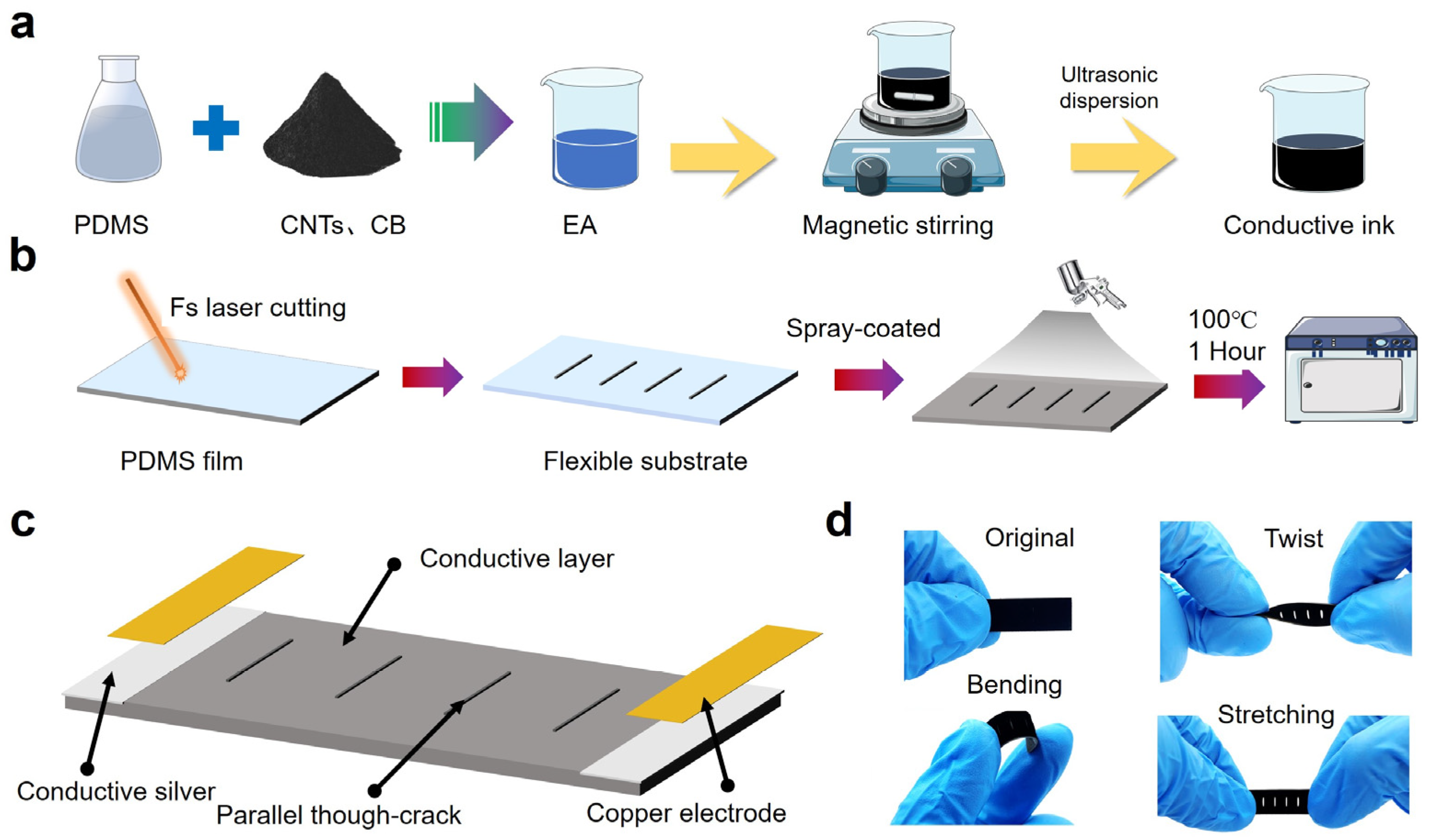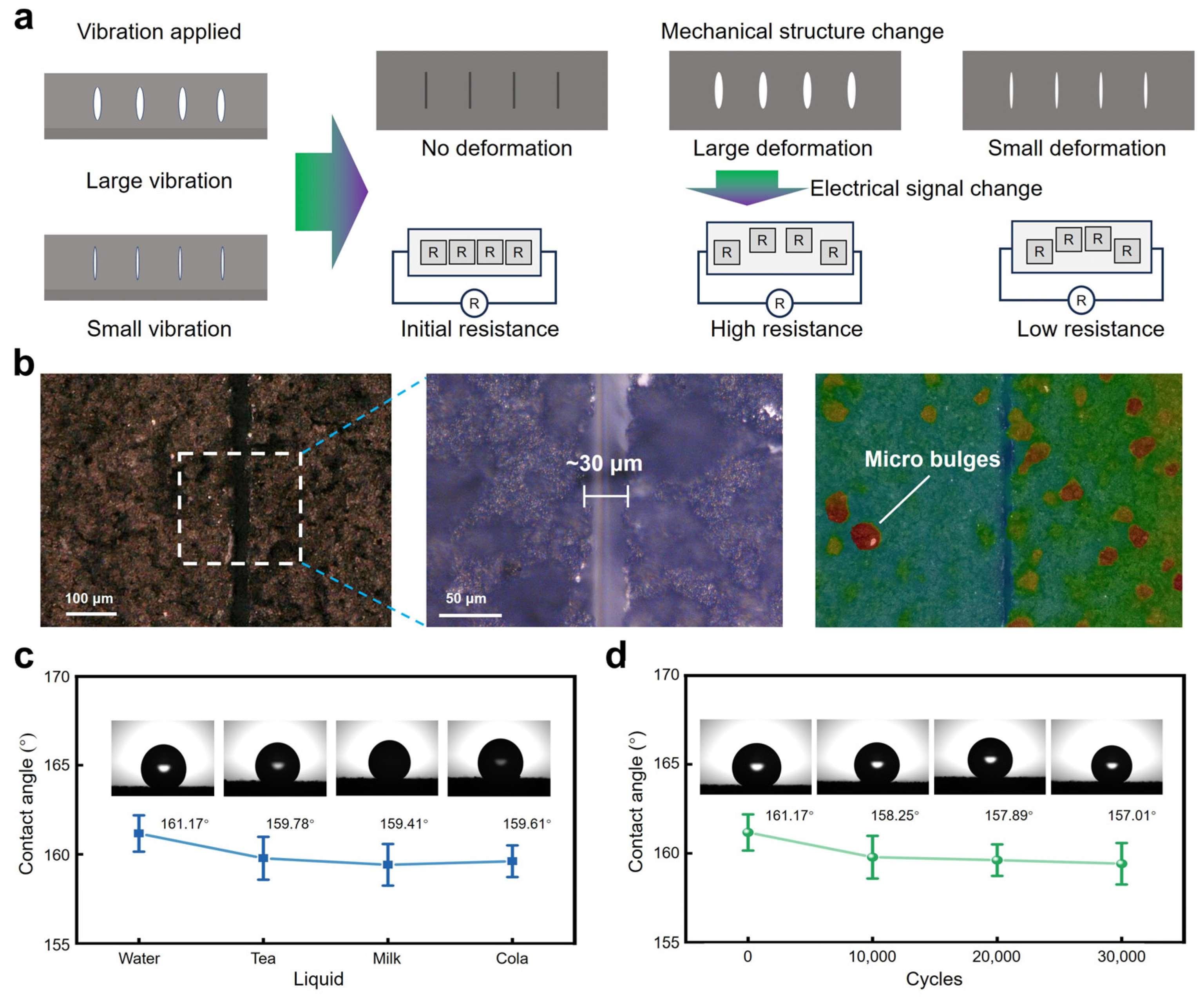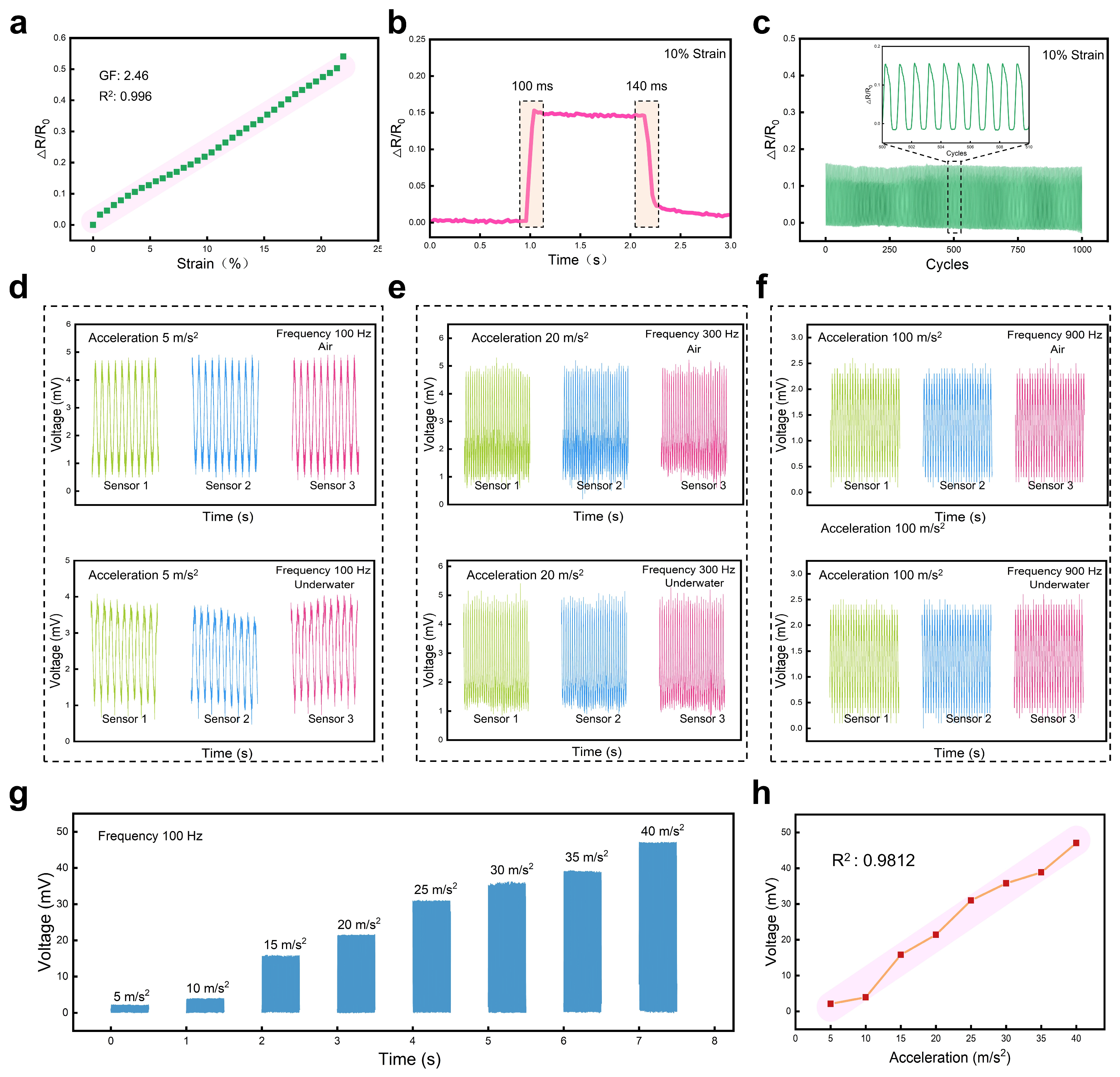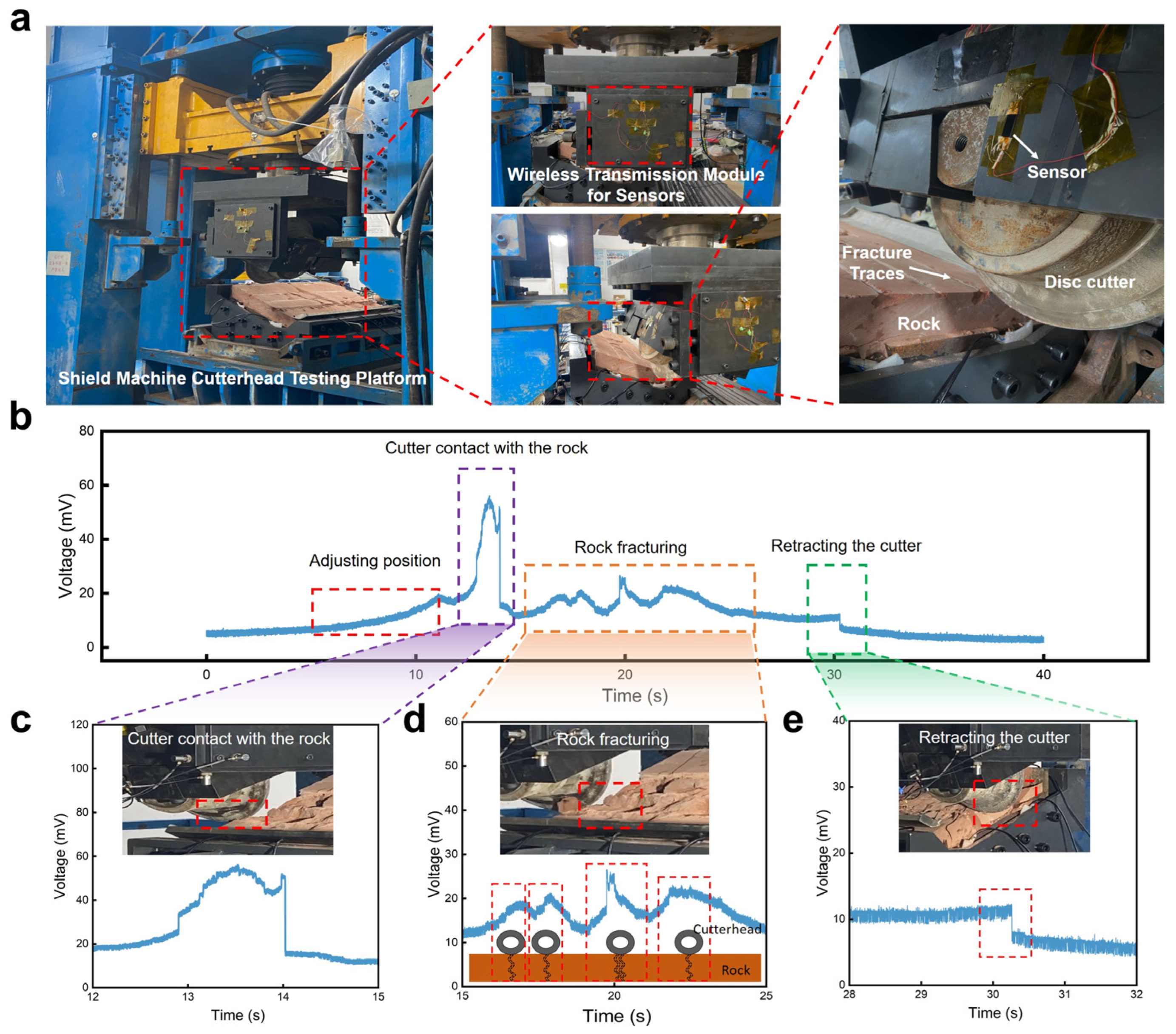Crack-Based Composite Flexible Sensor with Superhydrophobicity to Detect Strain and Vibration
Abstract
1. Introduction
2. Materials and Methods
2.1. Materials
2.2. Preparation of Conductive Ink
2.3. Preparation of Vibration Sensor
2.4. Characterization
3. Results and Discussion
3.1. Design of the Crack-Based Composite Flexible Sensor
3.2. Working Mechanism of the Crack-Based Composite Flexible Sensor
3.3. Sensing Performance of the Crack-Based Composite Flexible Sensor
3.4. Application of the Crack-Based Composite Flexible Sensor
4. Conclusions
Author Contributions
Funding
Institutional Review Board Statement
Data Availability Statement
Conflicts of Interest
References
- Zou, Y.; Sun, M.; Zhang, X.; Wang, J.; Li, F.; Dong, F.; Zhao, Z.; Du, T.; Ji, Y.; Sun, P.; et al. A Flexible, Adaptive, and Self-Powered Triboelectric Vibration Sensor with Conductive Sponge-Silicone for Machinery Condition Monitoring. Small 2024, 24, 2309759. [Google Scholar] [CrossRef]
- Elsheakh, D.N.; Fahmy, O.M.; Farouk, M.; Ezzat, K.; Eldamak, A.R. An Early Breast Cancer Detection by Using Wearable Flexible Sensors and Artificial Intelligent. IEEE Access 2024, 12, 48511–48529. [Google Scholar] [CrossRef]
- Januszko, A.; Iwan, A.; Maleczek, S.; Przybyl, W.; Pasternak, I.; Krajewska, A.; Strupinski, W. CVD-Graphene-Based Flexible, Thermoelectrochromic Sensor. J. Nanomater. 2017, 2017, 2757590. [Google Scholar] [CrossRef]
- Luo, W.; Sharma, V.; Young, D.J. A Paper-Based Flexible Tactile Sensor Array for Low-Cost Wearable Human Health Monitoring. J. Microelectromechanical Syst. 2020, 29, 825–831. [Google Scholar] [CrossRef]
- Li, X.; Xu, J.; Jiang, Y.; He, Z.; Liu, B.; Xie, H.; Li, H.; Li, Z.; Wang, Y.; Tai, H. Toward Agricultural Ammonia Volatilization Monitoring: A Flexible Polyaniline/Ti3C2Tx Hybrid Sensitive Films Based Gas Sensor. Sens. Actuators B Chem. 2020, 316, 128144. [Google Scholar] [CrossRef]
- Liu, L.Y.; Poddar, A.K.; Rohde, U.L.; Tong, M.S. A Novel Flexible Chipless RFID Tag Sensor for Monitoring Environmental Humidity. IEEE Sens. J. 2023, 23, 31237–31249. [Google Scholar] [CrossRef]
- Meng, X.; Sun, T.; Liu, L.; Zhang, C.; Zhao, H.; Wang, D.; Zhang, J.; Niu, S.; Han, Z.; Ren, L. Flexible Equivalent Strain Sensor with Ordered Concentric Circular Curved Cracks Inspired by Scorpion. ACS Appl. Mater. Interfaces 2022, 14, 29441–29450. [Google Scholar] [CrossRef]
- Zhang, Z.; Li, J.; Song, Y.; Sun, Y.; Zhang, X.; Hu, Y.; Guo, R.; Han, X. A Novel Ultrasound-Vibration Composite Sensor for Defects Detection of Electrical Equipment. IEEE Trans. Power Deliv. 2022, 37, 4477–4480. [Google Scholar] [CrossRef]
- Chowdhry, B.S.; Shaikh, F.K.; Ali, S.; Felemban, E. Experimental Evaluation of Vibration Response Based Bridge Damage Detection Using Wireless Sensor Networks. Wirel. Pers. Commun. 2015, 85, 499–510. [Google Scholar] [CrossRef]
- Zhang, X.; Zhao, J.; Fu, X.; Lin, Y.; Qi, Y.; Zhou, H.; Zhang, C. Broadband Vibration Energy Powered Autonomous Wireless Frequency Monitoring System Based on Triboelectric Nanogenerators. Nano Energy 2022, 98, 107209. [Google Scholar] [CrossRef]
- Xia, Y.; Sun, C.; Liu, W.; Wang, X.; Wen, K.; Feng, Z.; Zhang, G.; Fan, E.; He, Q.; Lin, Z.; et al. Ultra-Broadband Flexible Thin-Film Sensor for Sound Monitoring and Ultrasonic Diagnosis. Small 2024, 20, 202305678. [Google Scholar] [CrossRef]
- Navabian, N.; Beskhyroun, S.; Matulich, J. Development of Wireless Smart Sensor Network for Vibration-Based Structural Health Monitoring of Civil Structures. Struct. Infrastruct. Eng. 2022, 18, 345–361. [Google Scholar] [CrossRef]
- Mehamud, I.; Marklund, P.; Björling, M.; Shi, Y. Machine Condition Monitoring Enabled by Broad Range Vibration Frequency Detecting Triboelectric Nano-Generator (TENG)-Based Vibration Sensors. Nano Energy 2022, 98, 107292. [Google Scholar] [CrossRef]
- Liu, J.; Huang, H.; Zhou, Q.; Wu, C. Self-Powered Downhole Drilling Tools Vibration Sensor Based on Triboelectric Nanogenerator. IEEE Sens. J. 2022, 22, 2250–2258. [Google Scholar] [CrossRef]
- Li, S.; Qian, J.; Liu, J.; Xue, Y.; Zhang, J.; Liu, Y.; Hu, X.; Jing, X.; Zhang, W. Machine Learning-Assisted Wearable Triboelectric-Electromagnetic Vibration Sensor for Monitoring Human Rehabilitation Training. Mech. Syst. Signal Process. 2023, 201, 110679. [Google Scholar] [CrossRef]
- Wang, X.; Fu, W.; Gao, G.; Mehay, M.S.; Zheng, L.; Wang, H.; Zhao, W.; Loh, K.P.; Zhang, T.; Huang, W.; et al. Self-Cross-Linked Arrays Enabled Flexible Mechanical Sensors for Monitoring the Body Tremor. npj Flex. Electron. 2020, 4, 8. [Google Scholar] [CrossRef]
- Lin, Z.; Sun, C.; Liu, W.; Fan, E.; Zhang, G.; Tan, X.; Shen, Z.; Qiu, J.; Yang, J. A Self-Powered and High-Frequency Vibration Sensor with Layer-Powder-Layer Structure for Structural Health Monitoring. Nano Energy 2021, 90, 106366. [Google Scholar] [CrossRef]
- Gao, X.; Huang, M.; Zou, G.; Li, X.; Wang, Y. Self-Powered Vibration Sensor Based on the Coupling of Dual-Mode Triboelectric Nanogenerator and Non-Contact Electromagnetic Generator. Nano Energy 2023, 111, 108356. [Google Scholar] [CrossRef]
- Fang, Z.; Zhou, Z.; Yi, M.; Zhang, Z.; Luo, X.; Ahmed, A. A Roller-Bearing-Based Triboelectric Nanosensor for Freight Train Synergistic Maintenance in Smart Transportation. Nano Energy 2023, 106, 108089. [Google Scholar] [CrossRef]
- Zhang, Z.; Liu, C.; Li, H.; He, Z.; Zhao, X. Optical Fiber Grating Vibration Sensor for Vibration Monitoring of Hydraulic Pump. Photonic Sens. 2017, 7, 140–147. [Google Scholar] [CrossRef]
- Li, C.; Xue, Y.; Jia, P.; Jia, M.; Sun, B.; Xiong, J. A Wireless Passive Vibration Sensor Based on High-Temperature Ceramic for Harsh Environment. J. Sens. 2021, 2021, 8875907. [Google Scholar] [CrossRef]
- Huang, Y.; Tang, F.; Ma, D.; Liu, Z.; Wang, X. Design, Fabrication, Characterization, and Application of an Ultra-High Temperature 6H-SiC Sapphire Fiber Optic Vibration Sensor. IEEE Photonics J. 2019, 11, 1–12. [Google Scholar] [CrossRef]
- Yang, X.; Gui, J.; Dong, C.; Zhao, J.; Xu, R. Laser-Induced Graphene for Screen-Printed Strain Sensors. ACS Appl. Nano Mater. 2023, 6, 21679–21687. [Google Scholar] [CrossRef]
- Jiang, S.; Wang, J.; Sui, Q.; Ye, Q. Low-Cost Plate-Type MOEMS Uniaxial Vibration Sensor Based on Metal Etching and Fiber Collimator Technique. IEEE Sens. J. 2016, 16, 4816–4821. [Google Scholar] [CrossRef]
- Zhang, B.; Zhang, L.; Deng, W.; Jin, L.; Chun, F.; Pan, H.; Gu, B.; Zhang, H.; Lv, Z.; Yang, W.; et al. Self-Powered Acceleration Sensor Based on Liquid Metal Triboelectric Nanogenerator for Vibration Monitoring. ACS Nano 2017, 11, 7440–7446. [Google Scholar] [CrossRef]
- Alvarez Rueda, A.; Petritz, A.; Schäffner, P.; Postl, M.; Adler, M.; Belegratis, M.; Groten, J.; Stadlober, B. Vibration Energy Harvesting with Printed P(VDF:TrFE) Transducers to Power Condition Monitoring Sensors for Industrial and Manufacturing Equipment. Adv. Eng. Mater. 2024, 26, 2302140. [Google Scholar] [CrossRef]
- Wang, D.; Zhou, X.; Song, R.; Fang, C.; Wang, Z.; Wang, C.; Huang, Y. Freestanding Silver/Polypyrrole Composite Film for Multifunctional Sensor with Biomimetic Micropattern for Physiological Signals Monitoring. Chem. Eng. J. 2021, 404, 126940. [Google Scholar] [CrossRef]
- Miao, J.; Shi, Y.; Zhu, H.; Gao, M. Flexible Broad-Range Pressure Sensors Enabled by Deformation-Induced Conductive Channels in 3D Graphene Foam@Polydimethylsiloxane Composite for Precise Vibrational Signal Detection. Chin. J. Chem. 2020, 38, 719–724. [Google Scholar] [CrossRef]
- Zhang, D.; Xie, J.; Meng, X.; Pang, H.; Sun, R.; Fan, H.; Nan, X.; Zhou, Z. Development of Piezoresistive Flexible Sensor with Dual-Height Cylindrical Microstructure Surfaces to Achieve Vehicle Vibration Monitoring. J. Micromech. Microeng. 2024, 34, 075005. [Google Scholar] [CrossRef]
- Ding, Y.-R.; Xue, C.-H.; Guo, X.-J.; Wang, X.; Jia, S.-T.; An, Q.-F. Fabrication of TPE/CNTs Film at Air/Water Interface for Flexible and Superhydrophobic Wearable Sensors. Chem. Eng. J. 2021, 409, 128199. [Google Scholar] [CrossRef]
- Huang, J.; Yang, X.; Liu, J.; Her, S.; Guo, J.; Gu, J.; Guan, L. Vibration Monitoring Based on Flexible Multi-Walled Carbon Nanotube/Polydimethylsiloxane Film Sensor and the Application on Motion Signal Acquisition. Nanotechnology 2020, 31, 335504. [Google Scholar] [CrossRef]
- Zhao, Y.; Gao, S.; Zhang, X.; Huo, W.; Xu, H.; Chen, C.; Li, J.; Xu, K.; Huang, X. Fully Flexible Electromagnetic Vibration Sensors with Annular Field Confinement Origami Magnetic Membranes. Adv. Funct. Mater. 2020, 30, 202001553. [Google Scholar] [CrossRef]
- Luo, Y.; Xiao, Y.; Liu, J.; Wu, Y.; Zhao, Z. Design and Application of a Flexible Nano Cardiac Sound Sensor Based on P(VDF-TrFE)/KNN/GR Composite Piezoelectric Film for Heart Disease Diagnosis. Nanotechnology 2024, 35, 075502. [Google Scholar] [CrossRef] [PubMed]
- Wang, Y.; Jiang, C.; Dong, T.; Liu, X.; Chen, P.; Yu, X.; Yue, L.; Wang, Z. Flexible Micro-Nano Fiber Sensors for Tactile Sensing. IEEE Sens. J. 2024, 24, 4458–4463. [Google Scholar] [CrossRef]
- Lin, H.; Liu, D.; Zhou, Y.; Liu, M.; Huang, C.; Fu, Q.; Deng, K.; Huang, Y.; Huang, X.; Zhang, P.; et al. A Flexible PTI-CNT Strain Sensor with High Stretchable and Sensitive for Human Movement and Vocal Cord Vibration Monitoring. Polymer 2024, 299, 126887. [Google Scholar] [CrossRef]
- Liu, Y.F.; Liu, Q.; Li, Y.Q.; Huang, P.; Yao, J.Y.; Hu, N.; Fu, S.Y. Spider-Inspired Ultrasensitive Flexible Vibration Sensor for Multifunctional Sensing. ACS Appl. Mater. Interfaces 2020, 12, 30871–30881. [Google Scholar] [CrossRef] [PubMed]
- Zeng, Z.; Wu, N.; Yang, W.; Xu, H.; Liao, Y.; Li, C.; Luković, M.; Yang, Y.; Zhao, S.; Su, Z.; et al. Sustainable-Macromolecule-Assisted Preparation of Cross-linked, Ultralight, Flexible Graphene Aerogel Sensors toward Low-Frequency Strain/Pressure to High-Frequency Vibration Sensing. Small 2022, 18, 202202047. [Google Scholar] [CrossRef] [PubMed]
- Hou, Y.; Wang, L.; Wang, D.; Yang, H.; Guo, M.; Ye, Z.; Tong, X. A Preliminary Study on the IoT-Based Pavement Monitoring Platform Based on the Piezoelectric-Cantilever-Beam Powered Sensor. Adv. Mater. Sci. Eng. 2017, 2017, 4576026. [Google Scholar] [CrossRef]
- Suo, J.; Yang, X.; Leung, Y.; Wang, J.; Chen, M.; Liu, Y.; Sun, H.; Wang, Z.; Qiao, X.; Li, W.J. Enabling Natural Human-Computer Interaction through AI-Powered Nanocomposite IoT Throat Vibration Sensor. IEEE Internet Things J. 2024, 11, 24761–24774. [Google Scholar] [CrossRef]
- Won, J.; Park, J.; Park, J.-W.; Kim, I. BLESeis: Low-Cost IoT Sensor for Smart Earthquake Detection and Notification. Sensors 2020, 20, 2963. [Google Scholar] [CrossRef]
- Kim, T.-H.; Moeinnia, H.; Kim, W.S. 3D Printed Vorticella-Kirigami Inspired Sensors for Structural Health Monitoring in Internet-of-Things. Mater. Des. 2023, 234, 112332. [Google Scholar] [CrossRef]
- Wang, Q.; Yao, Z.; Zhang, C.; Song, H.; Ding, H.; Li, B.; Niu, S.; Huang, X.; Chen, C.; Han, Z.; et al. A Selective-Response Hypersensitive Bio-Inspired Strain Sensor Enabled by Hysteresis Effect and Parallel Through-Slits Structures. Nano-Micro Lett. 2024, 16, 26. [Google Scholar] [CrossRef] [PubMed]
- Dinh Le, T.-S.; An, J.; Huang, Y.; Vo, Q.; Boonruangkan, J.; Tran, T.; Kim, S.-W.; Sun, G.; Kim, Y.-J. Ultrasensitive Anti-Interference Voice Recognition by Bio-Inspired Skin-Attachable Self-Cleaning Acoustic Sensors. ACS Nano 2019, 13, 13293–13303. [Google Scholar] [CrossRef]
- Zhu, K.; Yang, S.; Jiang, H.; He, Y.; Chen, Z.; Zhang, B.; Zhang, Q.; Zhang, H. A Robust Biomass Superhydrophobic Sensor for Re-Healing and Underwater Vibration Detection. Carbon. 2024, 218, 118770. [Google Scholar] [CrossRef]
- Xu, R.; Zhang, K.; Xu, X.; He, M.; Lu, F.; Su, B. Superhydrophobic WS 2-Nanosheet-Wrapped Sponges for Underwater Detection of Tiny Vibration. Adv. Sci. 2018, 5, 201700655. [Google Scholar] [CrossRef]
- Duan, C.; Han, L.; Yang, G.; Schubert, D.W.; Zhang, T. Multi-Functional PDMS/MMT Coating on Magnesium Substrates: Hydrophobicity, Durability, and EMI Shielding. Mater. Today Commun. 2024, 39, 108603. [Google Scholar] [CrossRef]
- Rehman, M.A.; Hanif, M.; Umar, M.; Furqan, M.Q.; Younas, M.; Mehmood, U. Development of Polydimethylsiloxane (PDMS)-Based Hydrophobic Coating for Self-Clean Solar Panels. Arab. J. Sci. Eng. 2024, 49, 8079–8086. [Google Scholar] [CrossRef]
- Qi, X.; Li, X.; Jo, H.; Sideeq Bhat, K.; Kim, S.; An, J.; Kang, J.-W.; Lim, S. Mulberry Paper-Based Graphene Strain Sensor for Wearable Electronics with High Mechanical Strength. Sens. Actuators A Phys. 2020, 301, 111697. [Google Scholar] [CrossRef]
- Bhatta, T.; Pradhan, G.B.; Shrestha, K.; Jeong, S.H.; Zhang, S.; Kim, H.S.; Park, J.Y. All Elastomeric Pillars-Based Triboelectric Vibration Sensor for Self-Powered Broad Range Machinery Condition Monitoring. Nano Energy 2023, 117, 108929. [Google Scholar] [CrossRef]
- Liu, D.; Zhang, H.; Chen, H.; Lee, J.-H.; Guo, F.; Shen, X.; Zheng, Q.; Kim, J.-K. Wrinkled, Cracked and Bridged Carbon Networks for Highly Sensitive and Stretchable Strain Sensors. Compos. Part A Appl. Sci. Manuf. 2022, 163, 107221. [Google Scholar] [CrossRef]
- Liao, X.; Zhang, Z.; Liao, Q.; Liang, Q.; Ou, Y.; Xu, M.; Li, M.; Zhang, G.; Zhang, Y. Flexible and Printable Paper-Based Strain Sensors for Wearable and Large-Area Green Electronics. Nanoscale 2016, 8, 13025–13032. [Google Scholar] [CrossRef] [PubMed]
- Yao, D.-J.; Tang, Z.; Zhang, L.; Liu, Z.-G.; Sun, Q.-J.; Hu, S.-C.; Liu, Q.-X.; Tang, X.-G.; Ouyang, J. A Highly Sensitive, Foldable and Wearable Pressure Sensor Based on MXene-Coated Airlaid Paper for Electronic Skin. J. Mater. Chem. C 2021, 9, 12642–12649. [Google Scholar] [CrossRef]
- Hasnain, M.; Ullah, Z.; Sonil, N.I.; Ahmad, W.; Khalil, A.; Ali, S.M.; Mustafa, G.M.; Nazar, M.F.; Rouf, S.A.; Shamain, N.; et al. Ultrasensitive Strain Sensor Based on Graphite Coated Fibrous Frameworks for Security Applications. Mater. Today Commun. 2023, 37, 106859. [Google Scholar] [CrossRef]
- Zhou, J.; Long, X.; Huang, J.; Jiang, C.; Zhuo, F.; Guo, C.; Li, H.; Fu, Y.; Duan, H. Multiscale and Hierarchical Wrinkle Enhanced Graphene/Ecoflex Sensors Integrated with Human-Machine Interfaces and Cloud-Platform. NPJ Flex. Electron. 2022, 6, 55. [Google Scholar] [CrossRef] [PubMed]
- Bu, Y.; Shen, T.; Yang, W.; Yang, S.; Zhao, Y.; Liu, H.; Zheng, Y.; Liu, C.; Shen, C. Ultrasensitive Strain Sensor Based on Superhydrophobic Microcracked Conductive Ti3C2Tx MXene/Paper for Human-Motion Monitoring and E-Skin. Sci. Bull. 2021, 66, 1849–1857. [Google Scholar] [CrossRef]
- Liu, L.; Niu, S.; Zhang, J.; Mu, Z.; Li, J.; Li, B.; Meng, X.; Zhang, C.; Wang, Y.; Hou, T.; et al. Bioinspired, Omnidirectional, and Hypersensitive Flexible Strain Sensors. Adv. Mater. 2022, 34, 202200823. [Google Scholar] [CrossRef]
- Xia, J.; He, L.; Lu, Z.; Song, J.; Wang, Q.; Liu, L.; Tian, Y. High Performance Strain Sensor Based on Carbon Black/Graphene/Ecoflex for Human Health Monitoring and Vibration Signal Detection. ACS Appl. Nano Mater. 2023, 6, 19279–19289. [Google Scholar] [CrossRef]
- Tang, L.; Wu, S.; Qu, J.; Gong, L.; Tang, J. A Review of Conductive Hydrogel Used in Flexible Strain Sensor. Materials 2020, 13, 3947. [Google Scholar] [CrossRef]






Disclaimer/Publisher’s Note: The statements, opinions and data contained in all publications are solely those of the individual author(s) and contributor(s) and not of MDPI and/or the editor(s). MDPI and/or the editor(s) disclaim responsibility for any injury to people or property resulting from any ideas, methods, instructions or products referred to in the content. |
© 2024 by the authors. Licensee MDPI, Basel, Switzerland. This article is an open access article distributed under the terms and conditions of the Creative Commons Attribution (CC BY) license (https://creativecommons.org/licenses/by/4.0/).
Share and Cite
Zhang, Y.; Wu, H.; Liu, L.; Yang, Y.; Zhang, C.; Duan, J. Crack-Based Composite Flexible Sensor with Superhydrophobicity to Detect Strain and Vibration. Polymers 2024, 16, 2535. https://doi.org/10.3390/polym16172535
Zhang Y, Wu H, Liu L, Yang Y, Zhang C, Duan J. Crack-Based Composite Flexible Sensor with Superhydrophobicity to Detect Strain and Vibration. Polymers. 2024; 16(17):2535. https://doi.org/10.3390/polym16172535
Chicago/Turabian StyleZhang, Yazhou, Huansheng Wu, Linpeng Liu, Yang Yang, Changchao Zhang, and Ji’an Duan. 2024. "Crack-Based Composite Flexible Sensor with Superhydrophobicity to Detect Strain and Vibration" Polymers 16, no. 17: 2535. https://doi.org/10.3390/polym16172535
APA StyleZhang, Y., Wu, H., Liu, L., Yang, Y., Zhang, C., & Duan, J. (2024). Crack-Based Composite Flexible Sensor with Superhydrophobicity to Detect Strain and Vibration. Polymers, 16(17), 2535. https://doi.org/10.3390/polym16172535






